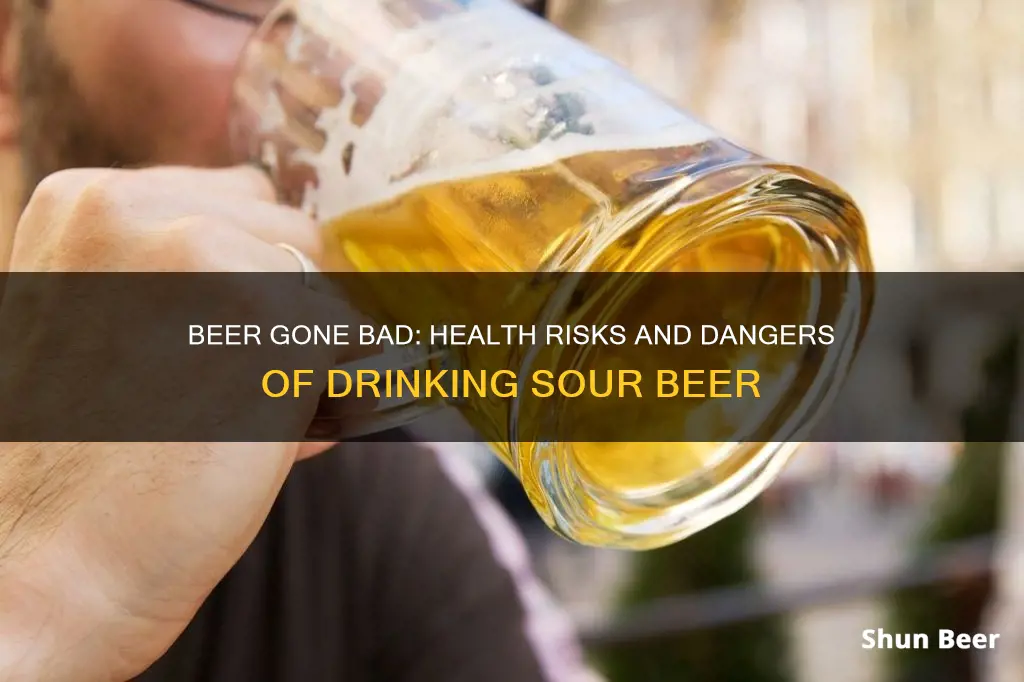
Drinking bad beer is unlikely to make you sick, but it might not taste very nice. Beer is a perishable product that can go stale when exposed to light, oxygen, and heat, which degrade the organic compounds that make beer smell and taste great. However, the fermentation process used in brewing, as well as its low pH level and alcohol content, make beer an unfriendly environment for microorganisms. So, even if a beer sits on the shelf for years, as long as it's sealed, it's unlikely to make you sick.
| Characteristics | Values |
|---|---|
| Safety | Drinking bad beer is harmless and will not make you sick |
| Taste | Bad beer will likely taste odd, flat, or stale |
| Smell | Bad beer will likely smell odd |
What You'll Learn
- Drinking bad beer is harmless, non-toxic, and won't make you sick
- Bad beer will likely smell odd and taste stale, flat, or sweet
- To prevent bad beer, store it in a cool, dark place, and consume within 3-6 months
- Beer goes bad due to oxygen, heat, and light, which cause oxidation and a papery taste
- Bad beer can taste like wet cardboard or have a vinegary taste, indicating bacteria

Drinking bad beer is harmless, non-toxic, and won't make you sick
Oxygen interacts with the compounds from malt, yeast, and hops, causing oxidation and a disappointing papery taste. The longer the beer is stored, the worse the taste gets. Once the beer is opened, oxidation goes into hyperdrive, and if the beer is left out for long, its flavour will deteriorate.
Heat speeds up oxidation, so storing beer in a refrigerator is recommended. Major changes in temperature, such as from an ice-cold cooler to a hot car, can also negatively impact the taste. Sadly, this change in flavour due to heat exposure is irreversible.
Lastly, light, especially UV light, can cause beer to develop a skunky odour and taste. Hop compounds are particularly sensitive to light and can become "light-struck", resulting in an unpleasant skunky taste. Beer is typically packaged in dark bottles or aluminium cans to protect it from light, but even these measures may not be enough to completely shield the beer from light exposure over time.
To prolong the shelf life of beer, it is recommended to store it in a cool, dark place, away from temperature fluctuations, and upright to minimize oxidation.
Beer Hawk: Craft Beer Discovery and Delivery
You may want to see also

Bad beer will likely smell odd and taste stale, flat, or sweet
Drinking bad beer is unlikely to make you sick, but it might not taste very nice. Bad beer will likely smell odd and taste stale, flat, or sweet.
Beer is a perishable product that stales when exposed to light, oxygen, and heat, which degrade the organic compounds that make beer smell and taste great. However, the fermentation process used in brewing beer, as well as its low pH level and alcohol content, make it very resistant to spoiling. Even if a beer sits on the shelf for years, as long as it's sealed, it's unlikely to make you sick.
The taste of beer changes over time, and what was once a refreshing treat could become a real stinker. Beers past their prime might taste like "wet cardboard", overly sweet, or develop the dreaded "skunkiness" that comes from the beer being left out in the sun too long.
The speed of the degradation of the aroma and flavour compounds in beer depends on the alcohol content of the beer and how it's stored. Beers with more alcohol by volume have a longer shelf life. Refrigerating beer slows the process of ageing, so always opt for beer that has been kept in the cooler, not on the shelf.
Vegan Beer: What's in Your Drink?
You may want to see also

To prevent bad beer, store it in a cool, dark place, and consume within 3-6 months
Drinking bad beer will not harm your health, but it will harm your taste buds. It will likely smell odd and taste stale, flat, or even like wet cardboard or sherry. To prevent this from happening, it's important to store beer in a cool, dark place, and to consume it within 3-6 months.
Beer is similar to wine in that it ages even after bottling, but unlike wine, its taste gets worse over time. Beer is perishable and will eventually go stale, as it is susceptible to light, oxygen, and heat exposure, which degrade its flavour and quality.
To prevent bad beer, it's best to store it in a cool, dark place, such as a refrigerator or cellar, and to consume it soon after purchase. Beer stored in a refrigerator can last up to two or three years if unopened, and opened beer can last about a day. Beer stored in a cool cellar can last up to 300 days.
Additionally, it's important to store beer upright and away from direct sunlight. Storing beer in cans is preferable to bottles, as cans are airtight and protect the beer from light exposure, slowing down the oxidation process.
By following these storage guidelines, you can help ensure that your beer stays fresh and flavourful, and avoid the unpleasant experience of drinking bad beer.
The Aging Beer Mystery: How Does it Work?
You may want to see also

Beer goes bad due to oxygen, heat, and light, which cause oxidation and a papery taste
Beer is susceptible to oxygen, heat, and light, which can cause oxidation and a papery taste. Beer exposed to oxygen can take on stale notes described as leathery, papery, wet cardboard-like, or catty. This is because oxygen degrades the lively alcohols and aromatics in the beer, turning them into bland shells of their former selves.
Oxygen can enter the beer at various stages of the brewing process, from the brewhouse to the fermentation cellar, and even within the bottle during storage. The more oxygen in the packaged beer, the faster it will become stale. The oxidation process can also bring back foes from fermentation, such as acetaldehyde, which can then turn into acetic acid, and diacetyl, which can speed up the staling process.
Heat also causes beer to go bad more quickly than if it were refrigerated or stored in a cool cellar. As a general rule, beer can be kept at 90°F for only 3 days before it goes bad, 30 days at 72°F, and up to 300 days at 38°F.
Light exposure, especially UV rays, can also cause beer to develop a skunky odour and taste, and this is more prevalent in beers packaged in clear or green bottles. Brown bottles offer better protection, and cans completely shield beer from light, helping to preserve its quality for longer.
Overall, while drinking oxidised beer is harmless, it is not an experience one willingly seeks due to the unpleasant tastes and aromas it can produce.
Why Beer Makes It Difficult to Pee
You may want to see also

Bad beer can taste like wet cardboard or have a vinegary taste, indicating bacteria
Drinking bad beer is harmless and non-toxic, but it might not taste good and will likely smell odd and taste stale or flat. Bad beer can taste like wet cardboard or have a vinegary taste, indicating bacteria. This is caused by oxidation, which occurs when oxygen negatively reacts with the molecules in the wort or beer. An excessive amount of oxygen being introduced to the beer, especially while the wort is still warm or after fermentation is complete, can create cardboard or sherry-like flavours.
Oxidation can be difficult to avoid because aeration of the wort before pitching yeast is necessary. It is almost always a result of unnecessary splashing of fermented beer (i.e. transferring beer from one vessel to another). Too much headspace in bottles can also lead to oxidation.
Only terribly oxidised beer will taste like wet cardboard. Slight oxidation will taste more like sherry or brandy and may be a bit darker.
To avoid oxidation, store beer upright, in a dark place, out of direct sunlight, and at the right temperature.
Heart Attack Recovery: Beer, Yes or No?
You may want to see also
Frequently asked questions
Drinking expired beer is harmless. Beer is pasteurized or filtered to eliminate bacteria, so it is extremely resistant to spoiling. It is unlikely to make you sick.
The taste of beer changes over time. It may become flat, stale, sweet, or malty.
Beer lasts about 5 to 9 months beyond the expiration date listed on the label if stored at room temperature. In a refrigerator, unopened beer can last up to 2 to 3 years. Opened beer has a shelf life of about a day.
If your beer has lost its fizz, or has a vinegary taste, it has likely gone bad.







